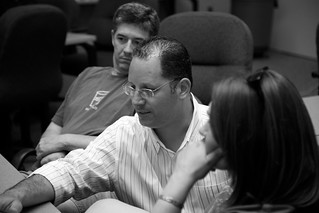What Came Before
Part 1: Before Meeting the First Class
Part 2: The First Class
Part 3: Digital Ethics (coming soon)
Part 4: Delicious and Flickr Assignments (coming soon)
Part 5: Wiki Solution Manuals (that's this post)
Some students have already started solving and annotating their problems tonight. Feel free to watch how it unfolds on the wiki.
Over this past weekend I created a new wiki and seeded it with exam level problems. The details are posted on the front page of the wiki, but in brief, the assignment comes in two parts done over two weeks:
A Significant Contribution or Week 1
Solve a problem completely. Annotate well enough so that an interested learner can learn from you. Make the layout clean, clear, and complimentary to the articulation of the solution.
Students often think this is the hard part of the assignment. I think it's the easy part. It's more or less like a Scribe Post focusing on a single problem. Granted, some of the problems are challenging, but the timeline for this, 1 week, is supposed to make it a low pressure sort of thing. Unless they leave it for the last possible moment; most don't some do. I mean, they have a week to do something that could reasonably be assigned as an overnight homework assignment.
A Constructive Modification or Week 2
This time next week the real fun begins. (The real metacognitive work.) Each student must scan through the entire wiki looking at each solution their mates have done, find one that has an error, and fix it. They must edit someone else's work, not their own.
 Week 1 was just a set up for this; this is where I think the real learning happens.
Week 1 was just a set up for this; this is where I think the real learning happens.
As they read through several solutions looking for errors they have to decide what is right or wrong and why. They question each line of every solution verifying each other's thinking as they read through. The hardest part for me, as the teacher, is to not say anything.
This all ties in with one of the three guiding principles I always think of as I design learning experiences for my students: Make Thinking Transparent. This is particularly well illustrated in this assignment.
Refinements or The Nuts and Bolts
The sidebar of the wiki has links to:
» the class blog.
» the grading rubric (feel free to copy it if you like, it's quite simple).
» an index of all the problems/units seeded on the wiki.
» the sitmo Google Gadget for create point & click LaTeX equations. (This makes it real easy to write math on the web.)
» equplus.net, a database of copy & paste LaTeX equations & expressions for those kids that really want to rock and roll with LaTeX.
Next in this series (when I've caught up with the backlog) is Part 6: Developing Expert Voices or Learning To Do What Mathematicians Do: create mathematics.
- 4/13/2009 09:39:00 pm
- 2 Comments



